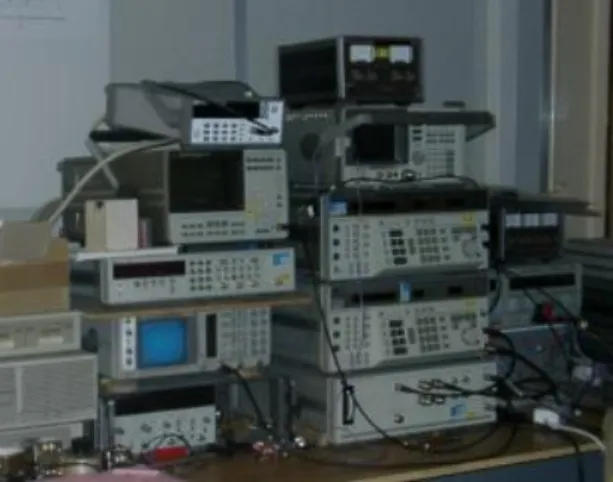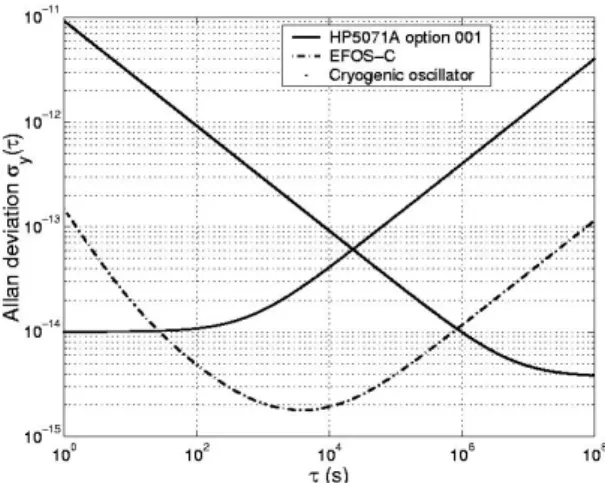HAL Id: hal-00022856
https://hal.archives-ouvertes.fr/hal-00022856
Submitted on 14 Apr 2006
HAL is a multi-disciplinary open access
archive for the deposit and dissemination of
sci-entific research documents, whether they are
pub-lished or not. The documents may come from
teaching and research institutions in France or
abroad, or from public or private research centers.
L’archive ouverte pluridisciplinaire HAL, est
destinée au dépôt et à la diffusion de documents
scientifiques de niveau recherche, publiés ou non,
émanant des établissements d’enseignement et de
recherche français ou étrangers, des laboratoires
publics ou privés.
Time and frequency metrology accredited laboratories in
Besançon
Patrice Salzenstein, François Meyer, Emmanuel Tisserand, Gilles Martin, Joël
Petetin, Nathalie Franquet, Franck Lardet-Vieudrin, Olivier Lavedrine, Michel
Vincent
To cite this version:
Patrice Salzenstein, François Meyer, Emmanuel Tisserand, Gilles Martin, Joël Petetin, et al.. Time
and frequency metrology accredited laboratories in Besançon. 2005, pp.559-562. �hal-00022856�
TIME AND FREQUENCY METROLOGY
ACCREDITED LABORATORIES IN BESANÇON
P. Salzenstein
1, F. Meyer
2, E. Tisserand
2, G. Martin
1, J. Petetin
2, N. Franquet
1, F. Lardet-Vieudrin
1, O.
Lavedrine
2and M. Vincent
21
FEMTO-ST Institute / LPMO & LCEP Dpt., CNRS UMR 6174
LNE associate laboratory No 2.13
32 avenue de l’Observatoire, 25044 Besançon Cedex
Phone: +33 (0)3 81 85 39 99, Fax: +33 (0)3 81 85 39 98, e-mail : patrice.salzenstein@lpmo.edu
2Observatoire de Besançon, CNRS UMR 6091,
LNE associate laboratory No 2.06
41bis, avenue de l’Observatoire, BP1615, F25010 Besançon, FRANCE
Phone: +33 (0)3 81 66 69 27, Fax: +33 (0)3 81 66 69 44, e-mail : francois.meyer@obs-besancon.fr
ABSTRACT
To organize traceability of any measurement to the national standards for calibration applications, Besançon is well equipped in the whole time and frequency domain. The LPMO department of the FEMTO-ST institute works on short term stability, spectral density of phase noise and ultra-stable oscillators. The observatory of Besançon is mainly involved in oscillator stability, chronometry, time scales and time and frequency transfer by GPS. Both laboratories are ISO 17025 accredited and associated to the Bureau National de Métrologie (BNM) – recently became the Laboratoire National de Métrologie et d’Essais (LNE).
By developing inter-laboratory time and frequency transfer by optical fiber, the laboratories are about to set up a local time scale of which long, middle and short term stability will be ensured by the observatory’s cesium clocks, FEMTO-ST’s hydrogen-maser and quartz or cryogenic oscillators. The current field of accreditation and the objectives of the two laboratories are presented in this paper.
KEYWORDS
Frequency stability, Phase noise, Time scale, Accreditation
INTRODUCTION
In France, for historical reasons, the time and frequency domain is geographically located in Paris and Besançon. Paris laboratories tradition in time measuring came from the observatories of Paris and Meudon when time references were an astronomers
affair. In the past, the development of watches industries and laboratories in Besançon explains the needs that lead to the development of metrological expertise in the time and frequency domain.
The main public laboratories in this domain are the following :
LNE-SYRTE previously called LPTF (Laboratoire Primaire du Temps et des Fréquences), is the French primary laboratory (National Metrological Institute) in charge for the French standards of time and frequency.
The observatory of Besançon, and its LNE associate laboratory (# 2.06) is the main actor in charge for the dissemination of the national frequency reference for both academic and industrial laboratories, ensuring the traceability of their local references to the national standards. The two following departments of FEMTO-ST institute, created in 2004 :
- LPMO (Laboratoire de Physique et Métrologie des Oscillateurs), and its LNE associate laboratory (# 2.13) that maintain and develop standards for short term frequency stability
- LCEP (Laboratoire de Chronométrie Electronique et Piézoélectricité) department that owns an Hydrogen Maser, standard for middle term frequency stability
The aim of this paper is to present the abilities of the accredited laboratory in the time and frequency
domain and some of the solutions that are under development for increasing their calibration capabilities.
1. SHORT TERM FREQUENCY STABILITY ACCREDITED LABORATORY Created in 1958 by Professors A. Kastler (Nobel Prize of physics) and J. Ubersfeld, the Laboratoire de l’Horloge Atomique, Besançon's section, had from this time a frequency-time vocation. This laboratory took the name of Laboratoire de Physique et Métrologie des Oscillateurs in 1974 (LPMO). Finaly it joined FEMTO-ST at the beginning of the year 2004 and then became one of the departments of this CNRS laboratory. For several years the LPMO has been associated to the University and the Institute of Micro-technologies of Franche-Comté (respectively UFC and IMFC). Since 1973, LPMO is accredited for short term frequency stability calibrations. LPMO is able to deliver COFRAC (Comité Français d’Accréditation) calibration certificates, conform to ISO 17025. That relates to short term frequency stability in time domain and phase noise measurements in spectral domain [1].
Fig. 1. Principle of the short term frequency stability calibration.
Despite the laboratory is able to fully characterize signals for several frequencies, it is officially accredited for characterizing Allan variance of 1 MHz-1 GHz frequency sources for integration time (τ) in the 0.1 s - 100 s range.
The best frequency stability that can be characterized under COFRAC accreditation is about 3.10-13 to 5.10-12 depending on carrier frequency and integration time.
The calibration is realized by comparison between the Unity Under Test (UUT) and a quartz reference locked on a Cesium. A frequency difference multiplier is then used to obtain a signal that can be analyzed by a frequency counter. Principle of this
calibration and a picture of the bench are given on the figures 1 and 2.
Fig. 2. Frequency stability calibration bench.
Fig. 3. Principle of the phase noise calibration. The LNE associate laboratory can calibrate any frequency sources between 5 MHz and 18 GHz in terms of phase noise, and the laboratory is well equipped to characterize frequency signals up to 40 GHz. Despite it is possible to give the phase noise for Fourier frequencies between 0.01 Hz and several MHz, the official calibration capabilities concerns the Fourier frequencies between 1 Hz and 100 kHz from the carrier.
Fig. 4. Phase noise bench.
The noise floor of this bench is between – 172 dBc/Hz and –55 dBc/Hz depending on the carrier
and the Fourier frequency. The principle of this calibration consists in locking a reference standard on the UUT. The beat note is then filtered and amplified to a Fast Fourier Transform (FFT) spectrum analyzer. Refer to figure 4 for photographs of the bench.
2. TIME INTERVAL, TIME STABILITY, FREQUENCY, FREQUENCY STABILITY
ACCREDITED LABORATORY
In 1871, the town council of Besançon expressed their wish to create a chronometric observatory to support the Besançon clock making industry. After 7 years of debates and negociation, a ministerial decree dated 11th of March, 1878, paved the way for an astronomical, chronometric and weather observatory in Besançon. In 1882, a convention is signed between the town of Besançon, the department of Doubs and the State, by which the city is committed to providing the ground and the buildings, the State to buying the instruments and paying the personnel, and the department to subsidizing a weather facility [2].
The observatory of Besançon has been one of the first accredited French laboratories, as it was recognized by the accreditation authorities in 1971. As written above, it is an LNE associate laboratory and ensures the traceability of the performed calibrations to the national standards; that relates to time interval, time stability, long term frequency and frequency stability measurements.
Three atomic clocks HP5071A-001 (1350172, 1350536 and 1351321) are operated at the observatory in a temperature/humidity controlled room. Those clocks participate to the Atomic International Time (TAI) and to the French Atomic Time TA(F) via 3 GPS receivers (2 Sercel NRT, 1 Ashtech Z12T).
The observatory delivers calibration certificates in time and frequency extending from simple wristwatches to atomic clocks. For frequency measurements, the laboratory can calibrate sources between 0.001 Hz and 1.3 GHz. For time interval measurements, it is in the 0.001s – 10,000 s range. For frequency stability, it is accredited for characterizing Allan variance for integration time in the 1h – 24 h range. The best frequency stability at 24 h that can be characterized under COFRAC accreditation is 2.10-14 after 30 days.
The observatory of Besançon is also involved in the development of instrumentation for time and frequency transfer by GPS [3] and realizes also specific developments in the time and frequency domain, for astronomical observatories, such as, for
example, the time tagging board for the Auger observatory [4].
3. INTER-LABORATORY TIME AND FREQUENCY TRANSFER BY OPTICAL
FIBER
All the available frequencies in the two time and frequency laboratories of Besançon (an hydrogen maser at the LCEP dpt. of FEMTO-ST, cryogenic resonator oscillators at the LPMO dpt of FEMTO-ST and cesium clocks at the LAOB) constitute the state of the art in term of time and frequency references. An optical inter-laboratory link of metrological quality makes it possible to share these frequency references between the three sites. Characterizing the optical link stability and developing a system to correct the phase fluctuations due to optical fibers, we wish to be able to transfer a signal stability of relative frequency of 2.10-15 for a few weeks [5].
Fig. 5. Optical link between the three laboratories. For short term frequency stability, ultra high stability signals are now available at the LPMO from cryogenic resonator - oscillator in X band. it transfers better than 10-14 short term frequency in the 10-100s range.
Fig. 6. Comparison of the stability of each reference in terms of Allan deviation σY(τ).
Best middle term stability is obtained using an hydrogen maser at the LCEP around 2.10-15 at
1000s. Atomic cesium clocks allows long term stability at the OB around 4.10-14 for 10 days. Moreover, the three cesium clocks at OB participate to both French atomic timescale TAF and international atomic timescale TAI.
It is possible to transfer the reference signals without degrading the frequency stability of the three different references.
FURTHER WORKS AND CONCLUSIONS The inter-laboratory time and frequency transfer by optical fiber will soon provide a local time and frequency scale in the laboratories.
In the next future, ultra high stability signals from cryogenic resonator - oscillator in X band will be able to provide a reference signal that would lead the LPMO dept to considerably increase its accredited capabilities in delivering short term frequency stability calibration certificate.
The observatory of Besançon has developed GPS “melting pot” (all in view) solutions to help the French time and frequency laboratories in ensuring their traceability to the national frequency references. It is also concerned in enhancing its own links to the national references and is currently working on establishing an accurate multi-channel common view GPS link with the primary laboratory (BNM-Syrte).
Both time and frequency accredited laboratories in Besançon plan to found together a new structure in order to constitute a new laboratory that will be able to fully characterize frequency sources from the short to the long term.
REFERENCES
[1] P. Salzenstein, G. Martin, N. Franquet, F. Lardet-Vieudrin and V. Giordano, Proposal for Calibration Accreditation in the Time & Frequency Domain, accepted by the COFRAC - French organism for accreditation, Besançon, France, september 2004
[2] Observatory of Besançon http://www.obs-besancon.fr/
[3] F. Meyer, N. Gautherot, Frequency transfer using low cost GPS receivers, Accessing national frequency references, in these proceedings.
[4] F. Meyer, P. A. Tuckey, F. Vernotte. Time tagging for the Auger observatory, Proceedings of the 16th European Frequency and Time Forum, St Petersburg, Russia, march 2002.
[5] J. Saalaoui, P. Salzenstein, F. Lardet-Vieudrin, S. Galliou, F. Vernotte and V. Giordano, Inter-laboratory time and frequency transfer by optical fiber, Proceedings of the VI International Conference for Young Researchers Wave Electronics and its Applications in Information and telecommunications Systems, St-Petersburg, Russia, 7-11 september 2003, A2 pp 5-8

